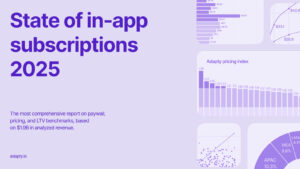What’s Really Working in In-App Subscription Models: Global Benchmarks from 11,000 Apps
 A new report analyzing $1.9 billion in in-app subscription revenue has surfaced surprising trends in how mobile users buy, churn, and commit. Based on 215 million transactions across 11,000+ apps, Adapty’s 2025 benchmark study offers one of the most comprehensive snapshots of real-world subscription behavior to date, revealing both what’s working and what’s quietly breaking.
A new report analyzing $1.9 billion in in-app subscription revenue has surfaced surprising trends in how mobile users buy, churn, and commit. Based on 215 million transactions across 11,000+ apps, Adapty’s 2025 benchmark study offers one of the most comprehensive snapshots of real-world subscription behavior to date, revealing both what’s working and what’s quietly breaking.
Key Findings
1. Weekly Plans Are Booming—but Retention Is a Crisis
Weekly subscriptions now make up nearly half of all in-app revenue globally—a 9.5% increase since 2024. They dominate in high-growth regions like LATAM (60% share) and MEA (53%), and are particularly common in categories like Utilities, Productivity, and Photo & Video.
But the growth comes at a cost: weekly plans have the steepest churn curves in the report.
-
65% of weekly subscriptions end within the first 30 days
-
Just 5% of users remain after one year
“Weekly plans reduce signup friction and are great for burst-use apps—but they quietly erode marketing ROI,” the report notes.
2. Free Trials Can Nearly Double Retention on Short-Term Plans
Adding a trial to a weekly plan boosts 30-day retention from 23% to 42%—nearly a 2x lift.
Across the board, trials drive stronger 12-month LTV:
-
+64% in the U.S.
-
+58% in Europe
-
Even in lower-ARPU regions like LATAM, trials increase LTV by 55%
Yet many apps still skip trials or default to minimal 1–3 day lengths. The report encourages aligning trial structure with the product’s core value timeline, not just copying category norms.
3. New Pricing Index Reveals Massive Gaps in Global Willingness to Pay
Adapty introduced a new “Pricing Index” that normalizes real-world subscription revenue by country, using the U.S. as a baseline (1.00). The findings show just how wide the pricing gap really is:
-
Netherlands: 1.62 (62% more expensive than U.S.)
-
Turkey: 0.29 (about 3.5x cheaper than U.S.)
Most companies still use generalized multipliers or gut feel when pricing globally. This index gives data-backed guidance on how to adjust pricing tiers for actual user spending behavior.
“Since 2022, the average subscription price has grown by 35%—a signal of real App Store inflation, particularly in Western markets.”
4. Mid-Tier Annual Plans Retain Worse Than Cheap or Premium Tiers
One of the more counterintuitive findings: middle-priced annual plans underperform in retention.
-
Lower- and higher-priced tiers retained better across multiple regions.
-
In annual plans, price sensitivity was strongest in the middle—not the top.
This challenges the assumption that mid-tier pricing is “safe” and suggests users may interpret it as ambiguous or low-value. The report warns: “If you can’t justify why a tier exists, people won’t commit to it.”
5. More A/B Testing = More Revenue
Apps that ran 50+ paywall experiments saw 10–100x more revenue than those that didn’t.
The most effective experiments were structural, not cosmetic:
-
Plan duration (weekly vs. monthly vs. annual)
-
Trial design (length, eligibility)
-
Price anchoring and plan mix
Tests that only adjusted visuals or text had much smaller performance lifts. The report emphasizes experimentation not just as a growth tactic—but a strategic discipline.
6. Direct Paywalls Outperform Trials in Some Categories
In categories like Lifestyle and Productivity, direct-to-paid flows convert better than trial-first funnels:
-
Install → Paid (no trial): 18–38% conversion
-
Install → Trial → Paid: often <1% in full-funnel conversion
This finding reinforces the need for funnel testing. Trials aren’t inherently better—they must be timed and framed around value delivery.
INSIDER TAKE
Though Adapty’s report is clearly a product of its platform ecosystem, the scale and quality of the data elevate it beyond standard marketing content. With insights drawn from 11,000+ subscription apps, 215 million transactions, and $1.9 billion in revenue, it offers rare, credible benchmarks for mobile-first businesses looking to optimize their monetization models.
What makes this research stand out isn’t just the depth—it’s the clarity. The trends around weekly pricing, trial effectiveness, and mid-tier churn aren’t just statistical—they point to concrete, fixable problems in how many apps approach revenue design.
The report also spotlights niche high-income markets like Qatar, Singapore, and Norway, where 12-month LTVs rival or exceed those of major economies—adding nuance to global growth strategy.
For subscription executives, especially those wrestling with low LTV or rising CAC, the message is clear:
-
Test more.
-
Price smarter.
-
Deliver value faster.
Retention isn’t about duration. It’s about recurring value moments. That’s what separates sticky products from leaky ones.




